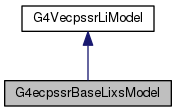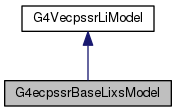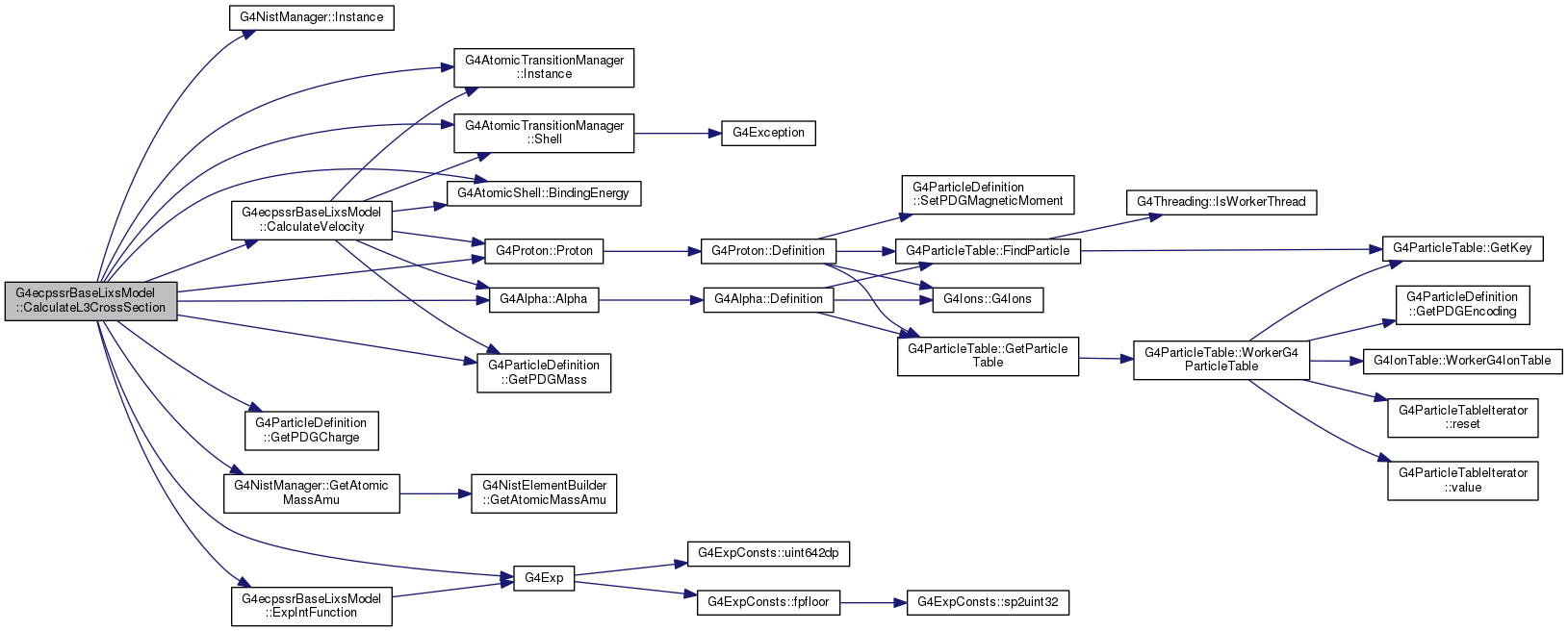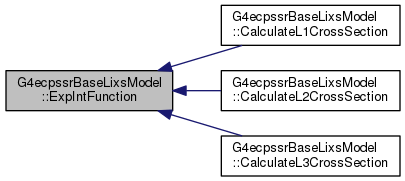194 if (zTarget <=4)
return 0.;
219 G4cout <<
"*** WARNING in G4ecpssrBaseLixsModel::CalculateL1CrossSection : Proton or Alpha incident particles only. " <<
G4endl;
228 static const G4double zlshell= 4.15;
230 G4double screenedzTarget = zTarget-zlshell;
231 static const G4double rydbergMeV= 13.6056923e-6;
235 G4double tetal1 = (l1BindingEnergy*nl*nl)/((screenedzTarget*screenedzTarget)*rydbergMeV);
238 if (verboseLevel>0)
G4cout <<
" tetal1=" << tetal1<<
G4endl;
240 G4double reducedEnergy = (energyIncident*
electron_mass_c2)/(massIncident*rydbergMeV*screenedzTarget*screenedzTarget);
246 G4double sigma0 = 8.*
pi*(zIncident*zIncident)*bohrPow2Barn*std::pow(screenedzTarget,-4.);
252 if (verboseLevel>0)
G4cout <<
" velocityl1=" << velocityl1<<
G4endl;
254 static const G4double l1AnalyticalApproximation= 1.5;
255 G4double x1 =(nl*l1AnalyticalApproximation)/velocityl1;
261 G4double electrIonizationEnergyl1=0.;
266 if ( x1<=0.035) electrIonizationEnergyl1= 0.75*
pi*(std::log(1./(x1*x1))-1.);
270 electrIonizationEnergyl1 =
G4Exp(-2.*x1)/(0.031+(0.213*std::pow(x1,0.5))+(0.005*x1)-(0.069*std::pow(x1,3./2.))+(0.324*x1*x1));
272 {
if ( x1<=11.) electrIonizationEnergyl1 =2.*
G4Exp(-2.*x1)/std::pow(x1,1.6);}
275 G4double hFunctionl1 =(electrIonizationEnergyl1*2.*nl)/(tetal1*std::pow(velocityl1,3));
278 if (verboseLevel>0)
G4cout <<
" hFunctionl1=" << hFunctionl1<<
G4endl;
280 G4double gFunctionl1 = (1.+(9.*velocityl1)+(31.*velocityl1*velocityl1)+(49.*std::pow(velocityl1,3.))+(162.*std::pow(velocityl1,4.))+(63.*std::pow(velocityl1,5.))+(18.*std::pow(velocityl1,6.))+(1.97*std::pow(velocityl1,7.)))/std::pow(1.+velocityl1,9.);
283 if (verboseLevel>0)
G4cout <<
" gFunctionl1=" << gFunctionl1<<
G4endl;
285 G4double sigmaPSS_l1 = 1.+(((2.*zIncident)/(screenedzTarget*tetal1))*(gFunctionl1-hFunctionl1));
290 if (verboseLevel>0)
G4cout <<
"sigmaPSS_l1 =" << sigmaPSS_l1<<
G4endl;
294 G4double yl1Formula=0.4*(screenedzTarget/cNaturalUnit)*(screenedzTarget/cNaturalUnit)/(nl*velocityl1/sigmaPSS_l1);
299 G4double l1relativityCorrection = std::pow((1.+(1.1*yl1Formula*yl1Formula)),0.5)+yl1Formula;
313 if ( velocityl1 <20. )
316 L1etaOverTheta2 =(reducedEnergy* l1relativityCorrection)/((tetal1*sigmaPSS_l1)*(tetal1*sigmaPSS_l1));
322 if ( ((tetal1*sigmaPSS_l1) >=0.2) && ((tetal1*sigmaPSS_l1) <=2.6670) && (L1etaOverTheta2>=0.1e-3) && (L1etaOverTheta2<=0.866e2) )
323 universalFunction_l1 = FunctionFL1((tetal1*sigmaPSS_l1),L1etaOverTheta2);
325 if (verboseLevel>0)
G4cout <<
"at low velocity range, universalFunction_l1 =" << universalFunction_l1 <<
G4endl;
327 sigmaPSSR_l1 = (sigma0/(tetal1*sigmaPSS_l1))*universalFunction_l1;
330 if (verboseLevel>0)
G4cout <<
" at low velocity range, sigma PWBA L1 CS = " << sigmaPSSR_l1<<
G4endl;
334 L1etaOverTheta2 = reducedEnergy/(tetal1*tetal1);
340 if ( (tetal1 >=0.2) && (tetal1 <=2.6670) && (L1etaOverTheta2>=0.1e-3) && (L1etaOverTheta2<=0.866e2) )
341 universalFunction_l1 = FunctionFL1(tetal1,L1etaOverTheta2);
343 if (verboseLevel>0)
G4cout <<
"at medium and high velocity range, universalFunction_l1 =" << universalFunction_l1 <<
G4endl;
345 sigmaPSSR_l1 = (sigma0/tetal1)*universalFunction_l1;
348 if (verboseLevel>0)
G4cout <<
" sigma PWBA L1 CS at medium and high velocity range = " << sigmaPSSR_l1<<
G4endl;
351 G4double pssDeltal1 = (4./(systemMass *sigmaPSS_l1*tetal1))*(sigmaPSS_l1/velocityl1)*(sigmaPSS_l1/velocityl1);
355 if (verboseLevel>0)
G4cout <<
" pssDeltal1=" << pssDeltal1<<
G4endl;
357 if (pssDeltal1>1)
return 0.;
359 G4double energyLossl1 = std::pow(1-pssDeltal1,0.5);
363 if (verboseLevel>0)
G4cout <<
" energyLossl1=" << energyLossl1<<
G4endl;
366 (8.*
pi*zIncident/systemMass)*std::pow(tetal1*sigmaPSS_l1,-2.)*std::pow(velocityl1/sigmaPSS_l1,-3.)*(zTarget/screenedzTarget);
370 G4double cParameterl1 =2.* coulombDeflectionl1/(energyLossl1*(energyLossl1+1.));
375 if (verboseLevel>0)
G4cout <<
" coulombDeflectionFunction_l1 =" << coulombDeflectionFunction_l1 <<
G4endl;
377 G4double crossSection_L1 = coulombDeflectionFunction_l1 * sigmaPSSR_l1;
382 if (verboseLevel>0)
G4cout <<
" crossSection_L1 =" << crossSection_L1 <<
G4endl;
384 if (crossSection_L1 >= 0)
386 return crossSection_L1 *
barn;
G4double ExpIntFunction(G4int n, G4double x)
G4double BindingEnergy() const
G4double CalculateVelocity(G4int subShell, G4int zTarget, G4double massIncident, G4double energyIncident)
static G4NistManager * Instance()
G4GLOB_DLL std::ostream G4cout
static constexpr double eplus
static G4Proton * Proton()
G4double G4Exp(G4double initial_x)
Exponential Function double precision.
G4double GetPDGMass() const
G4double GetAtomicMassAmu(const G4String &symb) const
static constexpr double pi
static constexpr double barn
G4double GetPDGCharge() const
static G4AtomicTransitionManager * Instance()
G4AtomicShell * Shell(G4int Z, size_t shellIndex) const


 Public Member Functions inherited from G4VecpssrLiModel
Public Member Functions inherited from G4VecpssrLiModel






